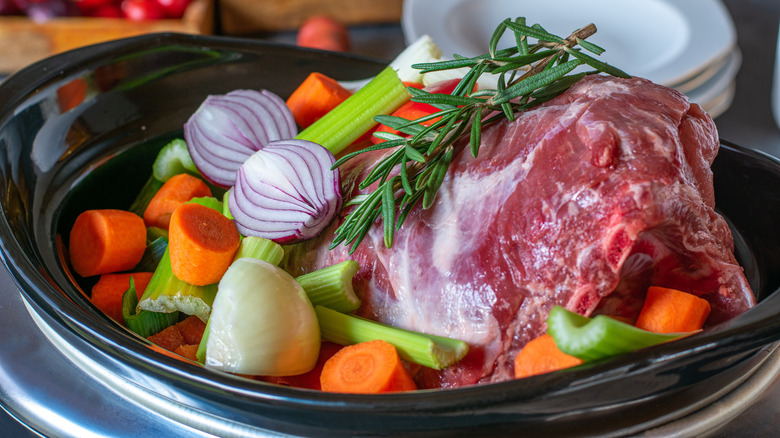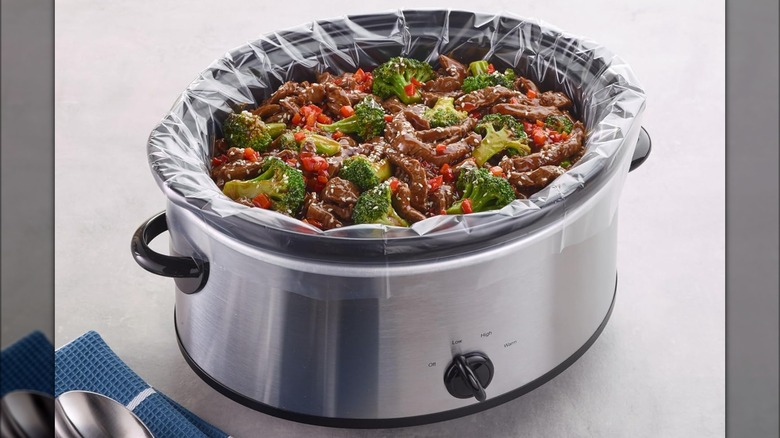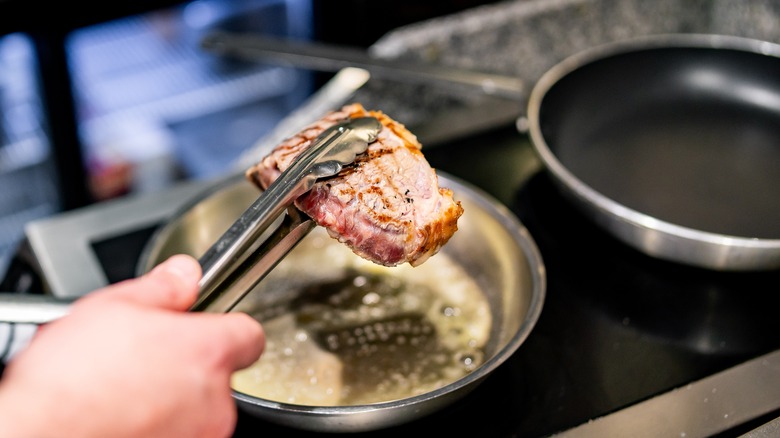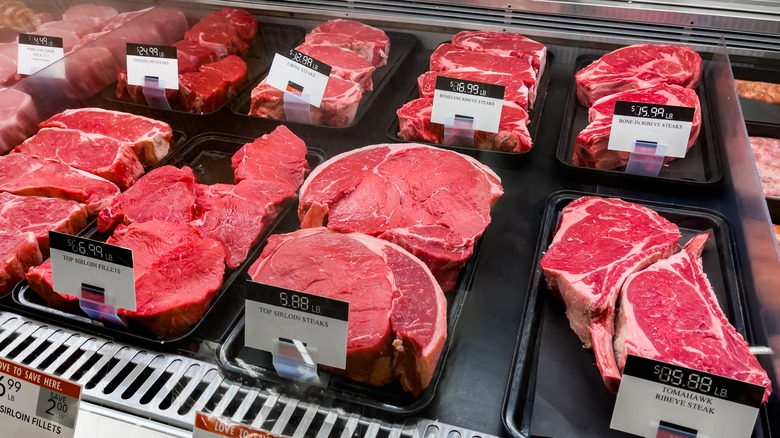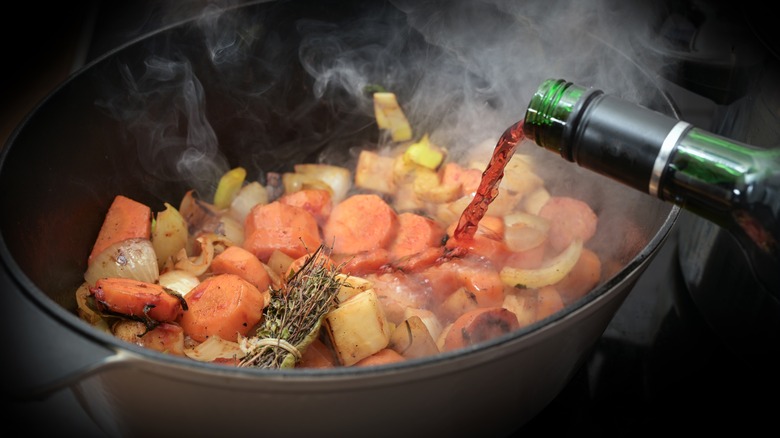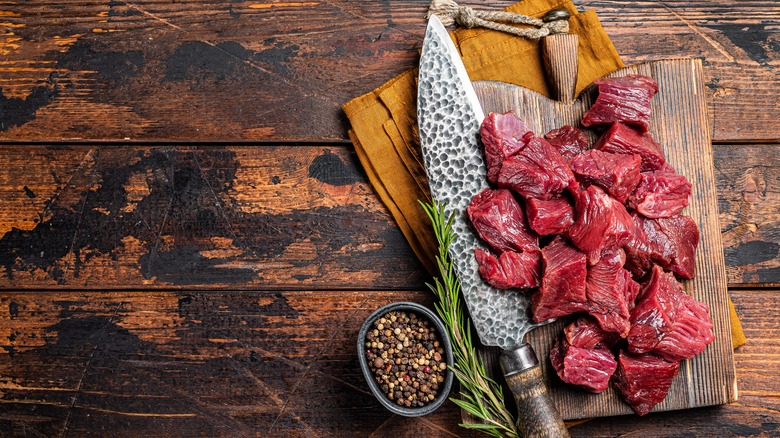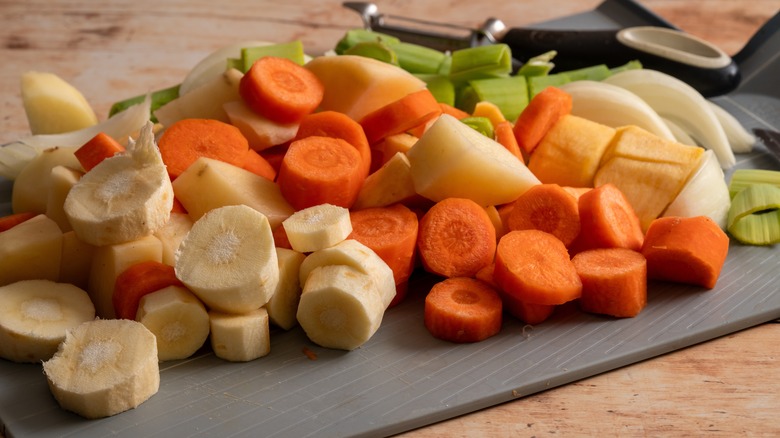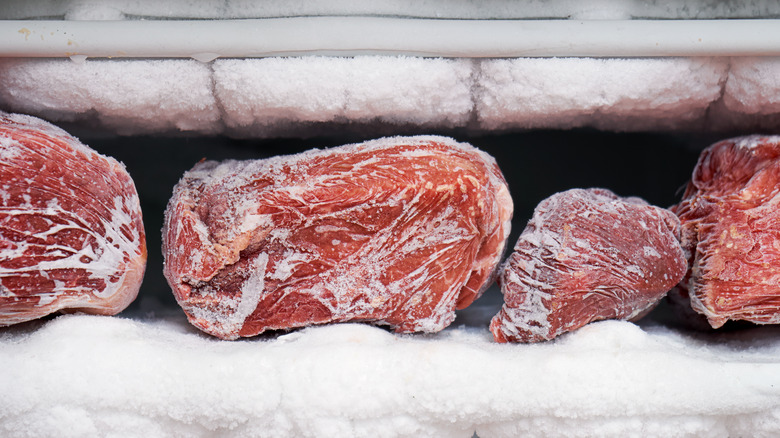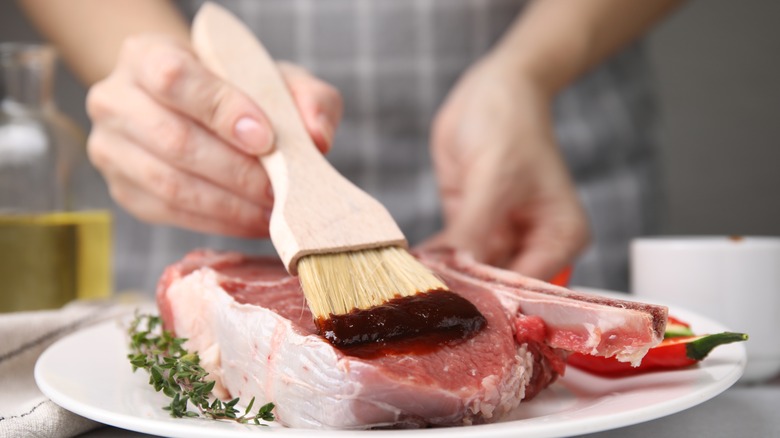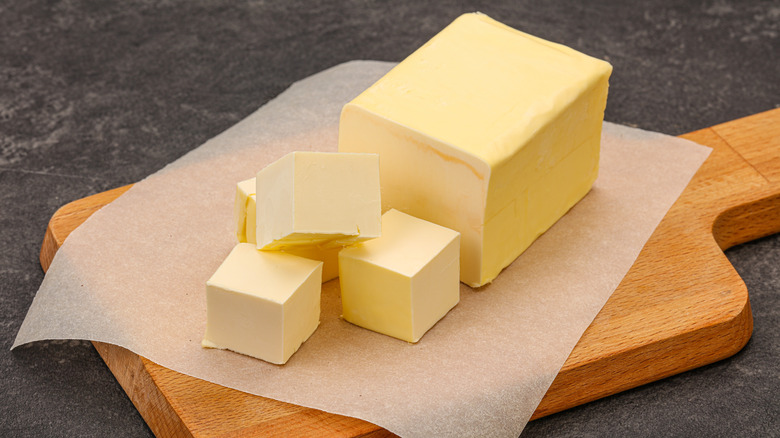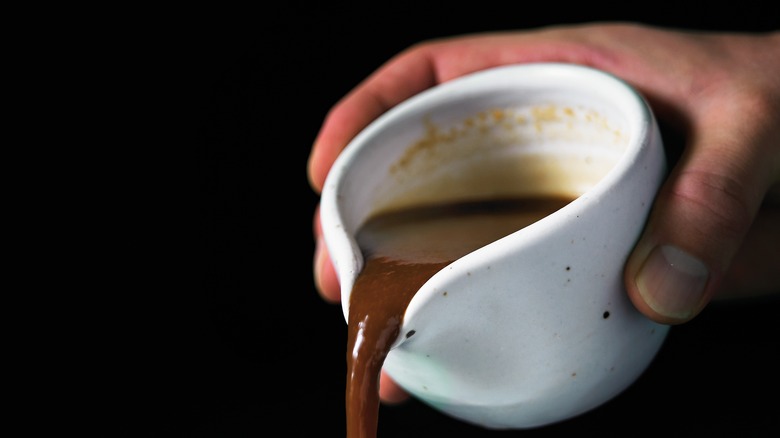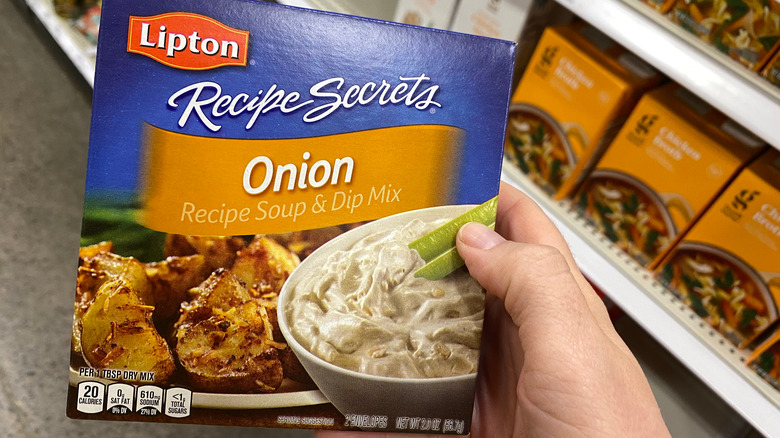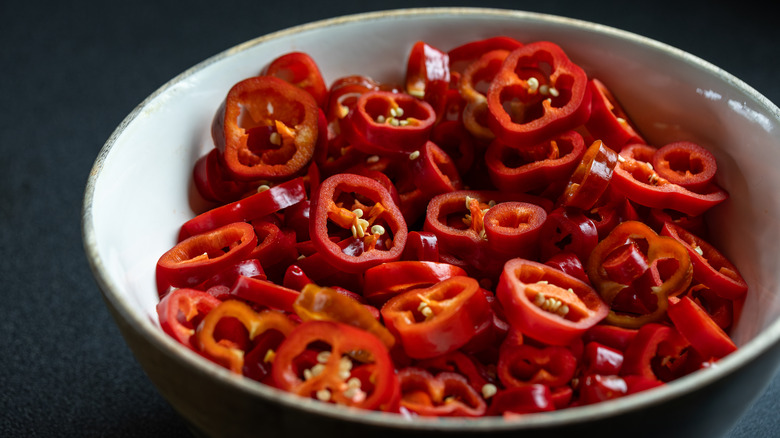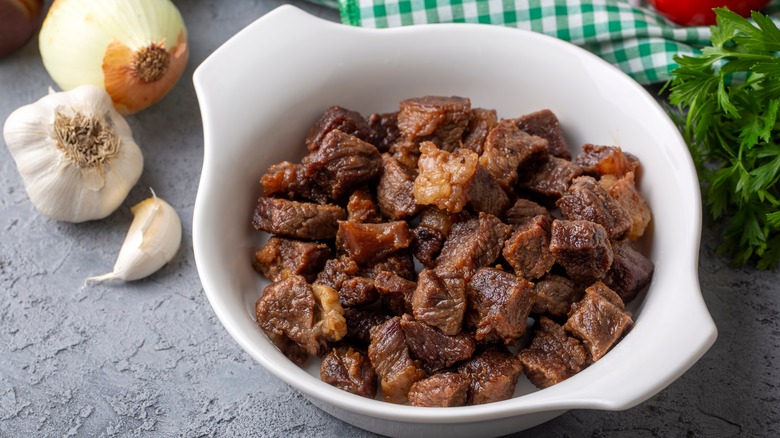13 Tips For Cooking Steak In A Slow Cooker
Does preparing steak in a slow cooker sound offensive to you? It might. After all, who would take a perfectly good steak and slow-cook it in a bunch of liquid? While we might not recommend that every steak cut be slow-cooked, there are certain steaks that might benefit from it. And because slow cooking tends to be a dump-and-go approach for meals, it can be a lifesaver when you don't have time to slave over the grill or stovetop.
We're going to reveal our favorite slow-cooker tips that can get you that much closer to achieving the steak of your dreams. These methods shed light on effective techniques to assist you in getting the most out of your steak while also providing ways to make the cooking process easier. It is our hope that you'll walk away with at least a couple of new ideas for how to make your next crock pot steak that much tastier.
Join us as we uncover 13 sizzling tips for cooking steak in a slow cooker.
1. Line your crock pot to make cleanup easier
If you're wondering whether you should use plastic liners in your slow cooker when making crock pot steak, the truth is that it helps. A crock pot liner is a plastic barrier that guards against mess; simply place the liner in your crock pot, cook, and eat. Once the crock pot has cooled, you can dispose of the liner, minimizing the time spent scrubbing your slow cooker clean.
When it comes to safety, liners should be used as directed. Reynolds Kitchen Slow Cooker Liners, for example, can withstand heat up to 400 degrees Fahrenheit and are BPA-free. Since most slow cookers operate between 170-300 degrees Fahrenheit, these liners will easily withstand the amount of heat used to simmer a slow cooker steak.
To use a crock pot liner for your slow cooker steak, place the liner in your crock pot, add your ingredients, and go about your recipe as you normally would. Additional oil or butter is not required when using a crock pot liner. Note that your crock pot should be left off until all of your ingredients are added; once you're ready to start cooking, set the crock pot to the suggested setting. As always, follow the specific instructions for your liner, taking special note of guidelines on its placement. Also, be sure to purchase the right liner to fit your crock pot size; dimensions are typically mentioned on the front of the package.
2. Sear steaks before slow cooking
Do you need to sear meat before slow cooking? Honestly, no. When cooking steak in a slow cooker, searing the meat first isn't necessary. In fact, the idea that it locks in moisture by sealing in juices is a myth. Even so, searing your steak before slow cooking could still benefit your meal. That's because searing enhances the flavor and texture of steak. You can thank the Maillard reaction for this truth; it is the chemical process that happens when proteins and sugars in meat make contact with heat to produce deliciously caramelized results.
To sear steak before slow cooking it, season it first and then crank up the heat on your pan to medium-high, adding a little oil, and cooking your steak on both sides. Cook times may vary, but you'll want to leave your steak on one side long enough for it to develop a deep brown color. Looking for a thick gravy to accompany your slow-cooked steak? Try dredging your steak in flour before following the aforementioned steps. The flour on the steak will work to naturally thicken into a gravy as it slow cooks in the liquid you've immersed it in.
3. Don't be afraid to use tougher cuts of meat
When cooking steak, the more tender the meat is, the better. That doesn't mean you have to skip on traditionally chewy cuts, though. Lower-cost tough meats can be made tender by utilizing longer cook times, making them perfect purchases for slow cooker steak recipes. Cuts of beef that do well using slow cooker techniques include beef sirloin, top round, stew meat, or even under blade steak (a totally underrated cut of steak ideal for slow cooking, by the way). We've even found an easy Crock Pot London Broil recipe made perfect with the addition of red wine, beef broth, Worcestershire sauce, and a couple pats of butter.
Even so, there are special ways you'll want to prepare tougher cuts of steak before placing them in your slow cooker. Be sure to stay tuned for additional tips on how to achieve the most tender texture possible for your slow cooker steak.
4. Add red wine and broth for flavor
As mentioned, you can add red wine to your slow cooker steak for amazing flavor. The benefits don't stop there; red wine also functions as an acid that can help tenderize your meat. How much red wine to use for slow cooker steak is up to you, but anywhere between half a cup to one full cup ( like with this super tender herb and fig pot roast recipe) is common. For the best results, follow the directions in your recipes so as not to add too much or too little wine to your slower cooker steak.
Don't want to use alcohol? It's perfectly acceptable to substitute beef broth in your slow cooker steak instead. The flavor won't be the same, but it'll work in a pinch, especially if you add a splash of vinegar to the mix. If using broth seems too boring, there are many other awesome substitutes for red wine. Try grape juice, red wine vinegar, cranberry juice, or even black tea. Whatever you do, just be sure not to skip out entirely on this key ingredient for your slow cooker. Using less liquid than what is called for in your recipe will likely lead to a dry slow-cooked steak.
5. Cut steaks into cubes for tender meat
Cutting steak into cubes before slow cooking has several benefits. Because the pieces are small, they tend to cook faster and produce more tender meat. As a result, dicing steaks proves an excellent technique for tougher cuts of beef like round, London broil, and sirloin. Other advantages to cutting steak into pieces ahead of time include uniformity, even cooking, and better absorption of flavors.
In addition, dicing raw steak into cubes often eliminates the need for a knife once you sit down to enjoy your finished meal. To ensure your steak pieces are truly bite-sized, try cutting them into 1-inch cubes. If you're in a rush and don't feel like whipping out the chopping board, certain steaks sold in stores come already diced and ready to cook; just know that these steak pieces, like those that come packaged as stew meat, might still prove too big. In that case, cut the pieces in half using a knife or kitchen sheers before searing or placing directly into your slow cooker.
6. Chop veggies into large pieces
The size of your veggies matters, as does their placement when adding them to your slow cooker steak. You should chop your carrots, potatoes, and onions coarsely since fine mincing may cause them to disintegrate. But there's more to it than just that; you'll also want to determine when to add your vegetables and where to place them in order to achieve the texture you want.
If you like your veggies well cooked and want them to absorb the meaty flavors emitted from your slow cooker steak, place them underneath the steak during the cooking process. For firmer veggies, place them on top. Keep in mind that placing your vegetables on top of your steak won't always allow them to soak up those beefy juices, but if you prefer to taste the pure flavors of your veggies, this method will work well. As far as when to add your veggies, go ahead and do so at the beginning; as long as you've chopped them coarsely enough, they should hold their shape well during cooking.
7. Resist the urge to put frozen steak in the crock pot
The crock pot is meant to make your life easier, but placing a frozen steak into a slow cooker isn't a good idea. According to the U.S. Department of Agriculture (USDA), it's best to fully thaw your meat before placing it into a crock pot. If you put your meat into a crock pot while it's still frozen, it will take longer to reach a safe internal temperature, thereby increasing the chances of foodborne illness. What's more, adding frozen meat to other ingredients (or removing the lid of your slow cooker to break up the frozen meat) will lower the overall temperature of the meal. Once that happens, the entire dish will take longer to cook — and no one wants that.
Remember also that when thawing your steak, you should do so in the fridge. The USDA advises against thawing meat on the counter at room temperature. Doing so may promote the growth of harmful bacteria.
8. Use a marinade with acid to help tenderize your beef
Marinating steak imparts flavor, but certain components in marinades also help tenderize the meat. When cooking steak in a slow cooker, it helps to use a marinade that contains acid. Acid works to make the meat more tender by breaking down the protein fibers in it. You can add various types of acid to a marinade, and many marinade recipes for steak already include them. For example, the acid in this 3-ingredient steak marinade is balsamic vinegar. Other acidic choices include apple cider vinegar, citrus juice, yogurt, and tomato paste.
And though submerging your steak in a marinade is an easy way to expose it to acid, it isn't the only way. Many slow cooker steak recipes, such as this slow cooker smothered steak, naturally include acid as a part of the liquid ingredients. All of this ensures that tougher steak cuts yield tender and pleasing results.
9. Include butter for extra richness
Butter might sound like a surprising ingredient to add to slow cooker steak, but doing so can create wonders in terms of richness. Very few slow cooker steak recipes we've come across include butter, but there are a few that do. This recipe for Mississippi pot roast lists butter as an ingredient, but don't think you have to make this style of slow cooker steak to use it. Adding a few pats of butter to almost any version of crock pot steak can boost flavor and add moisture.
To use butter in a crock pot steak recipe, simply add your ingredients to your crock pot and place the butter on top of your meat. The amount of butter you use is up to you, and since butter isn't a common ingredient in slow cooker steak recipes, you can put on your chef's hat and experiment with as little or as much as you want. Still in need of a general guideline? Anywhere between 2-4 pats of butter is likely more than enough.
10. Pour in Worchestire sauce to impart deep and distinct flavor
As with most recipes containing beef, Worcestershire sauce pairs perfectly with slow cooker steak. In case you aren't familiar with Worcestershire sauce, it is condiment consisting of a unique blend of vinegar, sugar, molasses, anchovies, and various spices that work to deliver deeply savory umami flavor.
When adding Worcestershire sauce to slow cooker steak, most recipes ask that you place a few tablespoons of it directly into the liquid in which you are cooking your meat. Alternatively, if you plan to marinate your steak beforehand, feel free to add Worcestershire sauce there as well. Usually, a splash or two of Worcestershire sauce will do, though you can put in as much or as little as you wish, depending on how well you like the flavor.
Another thing to note about Worcestershire sauce is that because it contains vinegar, it works as an acid to tenderize beef. Because of its many benefits, Worcestershire sauce is an excellent addition to the ingredients you use when cooking steak in a slow cooker.
11. Make seasoning easier
Though we prefer using spices from scratch, there are some days when coming up with our own seasoning blend takes more effort than we're willing to invest. On days like this, it can be helpful to use flavoring packets to make seasoning easier. There are a variety of flavoring packets available for slow cooker steak, including au jus mix, brown gravy mix, and dry ranch dressing seasoning. We also recommend experimenting with Lipton Onion Soup mix for incredibly savory results.
To use dry seasoning mixes when cooking steak in a slow cooker, dump the contents of the flavoring packets onto the meat, making sure that the meat is covered in the seasoning. From there, add the rest of your ingredients, turn on your slow cooker, and close the lid. From this point, you can cook your slow cooker steak recipe as you normally would.
Bear in mind that because most mixes tend to be higher in sodium, you likely won't need to add more salt to your recipe. We'd recommend sampling your slow cooker steak once it has finished cooking to see if it needs any more salt. This doesn't mean you can't add other seasonings at your leisure; infuse your slow cooker steak with extra garlic, pepper, or herbs in addition to your flavoring packets to yield slow-cooked steak that's quite literally bursting with flavor.
12. Add a bit of spice
You might not associate spiciness with steak made in a slow cooker, but it's actually a great way to add unexpected pizazz to your meat. There are many ways to add spice to steak, but one of the best options is to use peppers. Of course, not all peppers are spicy -– the Mississippi pot roast we mentioned earlier not only makes use of butter but mild-tasting peperoncini as well. Still, lovers of bold and spicy flavors can get in on the action, too. By simply throwing a few of your favorite hot peppers into the mix, you can turn your mom's old pot roast recipe into the ultimate spicy creation.
To add spicy peppers to your next crock pot steak, simply slice your peppers and place them directly in the liquid your steak is immersed in. Note that the amount of peppers you put in will affect how spicy your dish will be, so be sure to adjust accordingly.
Lastly, we want to remind you that fresh peppers aren't the only way to grace your slow cooker steak with heat. Add a splash of hot sauce or sprinkle in dried red pepper flakes to make adding spice even easier. You can even add multiple layers of heat within the dish by using a combination of these different spicy ingredients ... if you dare.
13. Be careful not to overcook your slow cooker steak
Crock pots are known to deliver unbelievably tender results, but there's a such thing as leaving steak to cook too long in a slow cooker. No matter how much liquid you use, there comes a point when slow cooker steak begins to dry out. The point at which your steak will reach this stage will depend on the type of steak you're using and how large it is.
To prevent your slow cooker steak from overcooking, it's advisable to leave your steak in the crock pot for only the recommended amount of time listed in your recipe. If you aren't working from a recipe, keeping your slow cooker steak on low for 6-8 hours typically does the trick. If you're cooking a larger piece of beef, like a large pot roast, for example, you may find that 6-8 hours isn't enough. Thus, if you need to tack on an extra hour or more, go ahead; just be sure to check on the meat every so often until it reaches the desired result.
There are plenty of stories about home cooks who left slow cooker steaks in the crock pot too long only to be met with an incredibly dry and burnt dinner. You may have to experiment with times and liquid measurements to find what works best. But once your slow cooker steak has reached a safe temperature and is cooked the way you like it, shut off your crock pot.
